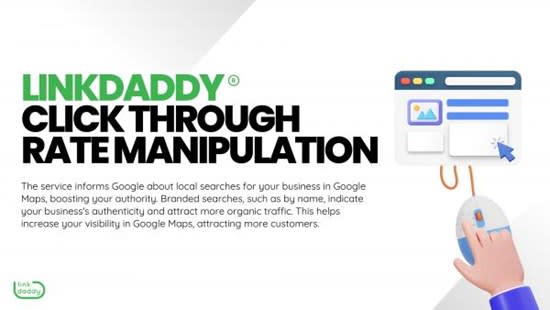GMB CTR Manipulation-- Increase Clicks for Your Google My Company Listing
GMB CTR Manipulation-- Increase Clicks for Your Google My Company Listing
Blog Article
CTR Adjustment: A Video Game Changer for Digital Campaigns
The rise of CTR control has actually undeniably changed electronic advertising and marketing techniques, supplying marketing experts with tools to enhance interaction and drive website traffic efficiently. What implications might this stabilizing act hold for the future of electronic projects?
Comprehending CTR Control
Although click-through rate (CTR) control may feel like a simple strategy in electronic advertising and marketing, it includes a series of techniques targeted at unnaturally inflating involvement metrics. This control can take numerous forms, consisting of the usage of click ranches, robots, or deceitful ad placements that misinform consumers right into clicking. These strategies can endanger the stability of efficiency information, making it challenging for online marketers to gauge the real effectiveness of their projects.
Moreover, CTR control raises honest concerns, as it undermines the openness of electronic advertising and marketing. The reliance on filled with air metrics can lead to misdirected advertising and marketing choices, skewing resource appropriation and campaign techniques. Subsequently, services may invest greatly in networks and tactics that appear successful yet do not produce genuine involvement or conversions.

Benefits of Click-Through Rate Optimization
Enhancing click-through rate (CTR) is necessary for boosting the efficiency of electronic advertising and marketing campaigns. A greater CTR suggests that a bigger proportion of users are engaging with the web content, which can bring about increased website traffic and far better conversion prices. By improving CTR, brand names can properly allocate their advertising sources to efforts that yield the highest possible returns.
One of the key benefits of CTR optimization is the possibility for enhanced advertisement positioning and lower expenses - CTR Manipulation. Platforms like Google Advertisements compensate greater CTRs with far better advertisement positioning and reduced cost-per-click (CPC), allowing marketing experts to extend their spending plans better. Additionally, a well-optimized CTR can boost brand presence, as greater involvement rates commonly correlate with enhanced natural reach

Methods for Reliable CTR Control
To properly adjust click-through prices (CTR), marketing experts can use a variety of calculated methods that enhance user engagement and drive traffic. One essential strategy is maximizing ad copy to create compelling and action-oriented language. CTR Manipulation. Using strong call-to-action (CTA) phrases urges individuals to take instant activity, increasing the possibility of clicks
Another efficient strategy is A/B screening, which allows marketing experts to contrast different ad variants. By systematically analyzing performance metrics, they can recognize which components resonate ideal with the target market, consequently improving their approaches for maximum influence. Additionally, leveraging aesthetically appealing graphics and concise messaging can catch interest quickly, making it extra probable that individuals will involve.

Finally, optimizing touchdown pages to make sure a smooth user experience can decrease bounce prices and urge more interaction, inevitably cultivating higher CTR. By incorporating these strategies, marketers can successfully manipulate CTR to achieve their project goals.
Gauging Success in Digital Campaigns
Determining success in electronic projects calls for a clear understanding of vital efficiency indications (KPIs) that line up with campaign goals. KPIs work as measurable metrics that help evaluate the effectiveness of various techniques employed throughout the project. Usual KPIs consist of click-through rates (CTR), conversion rates, cost per acquisition (CPA), and roi (ROI)
To effectively determine success, it is critical to establish certain, quantifiable goals first of the campaign. If the primary purpose is to enhance brand awareness, metrics such as perceptions and involvement rates might be prioritized. On the other hand, campaigns concentrated on straight sales would certainly profit from an extra detailed evaluation of conversion rates and income produced.
Regular analysis of these KPIs enables marketing professionals to make data-driven decisions, maximizing their approaches in real-time. Utilizing analytical tools can assist in monitoring performance and recognizing fads, enabling quick adjustments to enhance project results. Ultimately, a detailed technique to gauging success not only highlights locations for renovation yet also strengthens the total efficiency of digital marketing efforts, driving continual development and involvement in the long-term.
Future Trends in Digital Advertising
Anticipating the future of digital advertising and marketing reveals a landscape formed by fast technical advancements and transforming customer habits. As expert system click and artificial intelligence remain to advance, marketing experts will increasingly take advantage of these technologies to personalize projects at an unprecedented scale. Anticipating analytics will certainly enable brand names to prepare for consumer demands, maximizing ad placements and material shipment in genuine time.
Moreover, the surge of voice search and smart devices is changing how you can look here consumers communicate with digital content. Marketing professionals will certainly need to adjust their approaches to make certain presence across several systems, consisting of voice-activated assistants. This shift necessitates a concentrate on conversational advertising and marketing, highlighting interaction via discussion rather than traditional marketing tactics.
Furthermore, privacy concerns are triggering changes in information collection practices. Openness and ethical data usage will come to be vital, driving brands to cultivate depend on and commitment among customers. The recurring evolution of social media platforms will certainly likewise affect advertising and marketing approaches, with a heightened emphasis on authenticity and user-generated content.
Final Thought
In summary, CTR control stands for a substantial advancement in electronic advertising strategies, offering immediate advantages via boosted interaction metrics. The recurring advancement of electronic advertising and marketing will depend on this fragile interaction, forming the future landscape of brand-consumer communications.
Report this page